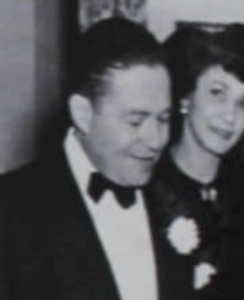
Alonzo J. Aden
*Alonzo J. Aden was born on May 6, 1906. He was a Gay Black art historian and gallerist.
Alonzo "Lonnie" Aden was born in Spartanburg, South Carolina. He was the oldest son of Ephraim Aden, a hotelier, and Naomi Barnett, a schoolteacher. Aden had blonde hair until early adulthood and green eyes. In 1920, Aden was sent to Washington, D.C., to live with his uncle, James, and his wife, Laura.
After graduating from Armstrong High School, he attended Hampton Institute (now Hampton University). In 1927, Aden wrote for The Crisis magazine. That fall, he started classes at Howard University and enrolled in an art history class taught by James V. Herring.
The pair lived together in 1929 in a home on 2nd Street in Washington, DC. The pair were stylish Washington, DC socialites, entertaining several times a week. Aden favored tailored suits, and Herring sported a cape and cane during the winter months and a white dinner jacket during the summer social season. In 1930, Aden began working in the university art gallery as an undergraduate assistant to Herring. He would rise through the ranks and eventually become the Howard University Gallery of Art curator. In 1933, Aden graduated from Howard with a bachelor's degree in education.
In 1935, Aden received a Rockefeller Foundation scholarship for a sixteen-week apprenticeship in the Visual Education Department at the Buffalo Museum of Science. He took a leave of absence from Howard to complete the apprenticeship. In 1936, Aden worked with the United States Department of Commerce as the curator of the "Hall of Negro Life" at the Texas Centennial Exposition. The Hall of Negro Life attracted more than 400,000 visitors. In 1938, Aden got a travel grant to study in Europe. He visited museums, galleries, and other artistic spaces in Berlin, Brussels, Cologne, Dresden, Florence, London, Munich, Rome, and Venice.
The following year, he returned to the Howard Art Gallery. In 1940, Alain Locke invited Aden to serve as curator of the exhibition held in the Tanner Hall Galleries. The National Gallery of Art commissioned Aden to deliver a "curatorial lecture" series in 1941 and 1942. In 1943, after ten years of service as curator, Aden resigned as head of the Howard University Art Gallery. In 1943, Aden co-founded with Herring the Barnett-Aden Gallery, one of the first Black-owned art galleries in the United States.
The gallery was named in honor of Aden's mother, Naomi Barnett-Aden, who was a "benefactor" of the gallery by giving $1,000 to her son's new venture. The gallery maintained a sales policy where each artist retained all the money for their art sale yet was required to contribute at least one object to the Barnett-Aden art collection.
Aden and Herring, who were 19 years older than Aden, were business and life partners. On October 13, 1961, Alonzo Aden suffered a heart attack at home and died. After Aden's death, the Barnett-Aden Gallery began to decline and slowly ceased its exhibition schedule. Aden's partner, James Herring, died in 1969, and the gallery closed. In 1989, a portion of the Barnett-Aden Collection, approximately 130 artworks, was sold for six million dollars to the Florida Endowment Fund for Higher Education.
At the time, this was the largest recorded price for a Black art collection acquisition. In 1998, Robert L. Johnson purchased a lot from the Barnett-Aden Collection. In 2015, Johnson donated select works from the Collection to the National Museum of African American History and Culture. As a permanent legacy to Aden and Barnett, Cultural Tourism DC erected a Barnett Aden Gallery memorial marker on the African American Heritage Trail in Washington, DC.